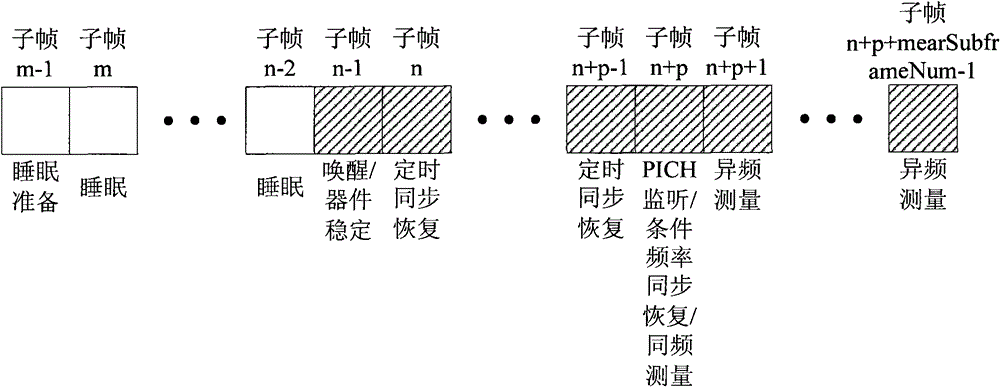A processing method for sleep wake-up of a mobile terminal
A mobile terminal and processing method technology, applied in power management, advanced technology, electrical components, etc., can solve the problems of UE paging monitoring and measurement reliability, affecting UE synchronization recovery performance, etc., to achieve frequency synchronization recovery, improve The effect of sync recovery performance
- Summary
- Abstract
- Description
- Claims
- Application Information
AI Technical Summary
Problems solved by technology
Method used
Image
Examples
specific Embodiment 1
[0070] The UE sleep wake-up processing flow of this specific embodiment is as follows figure 2 Shown:
[0071] In this embodiment, the UE needs 1 subframe to complete device stabilization, and p subframes are needed to restore timing synchronization;
[0072] 1. In the idle mode, the UE receives and interprets the system information, and obtains the position of the subframe where the physical channel under each system information block is located;
[0073] 2. The UE judges whether the arrival time of a subframe carrying a certain type of system information block is within a specific range. If yes, perform step 3; otherwise, perform step 9
[0074] Wherein, the specific range is the subframe where the PICH is located - T ~ the subframe where the PICH is located + T time range; T is the time required for the UE to measure the cell during this wake-up process;
[0075] In this embodiment, the subframe PICH carrying the MIB within a specific range always appears before the subf...
specific Embodiment 2
[0093] The UE sleep wake-up processing flow of this specific embodiment is as follows image 3 Shown:
[0094] In this embodiment, the UE needs 1 subframe to complete device stabilization, and p subframes are needed to restore timing synchronization;
[0095] 1. In the idle mode, the UE receives and interprets the system information, and obtains the position of the subframe where the physical channel under each system information block is located;
[0096] 2. The UE judges whether the arrival time of a subframe carrying a certain type of system information block is within a specific range. If yes, perform step 3; otherwise, perform step 9
[0097] Wherein, the specific range is the subframe where the PICH is located - T ~ the subframe where the PICH is located + T time range; T is the time required for the UE to measure the cell during this wake-up process;
[0098] In this embodiment, the subframe bearing SIB2 occurs at intervals between the subframes where the PICH is loca...
specific Embodiment 3
[0115] The UE sleep wake-up processing flow of this specific embodiment is as follows Figure 4 Shown:
[0116] In this embodiment, the UE needs 1 subframe to complete device stabilization, and p subframes are needed to restore timing synchronization;
[0117] 1. In the idle mode, the UE receives and interprets the system information, and obtains the position of the subframe where the physical channel under each system information block is located;
[0118] 2. The UE judges whether the arrival time of a subframe carrying a system information block of a certain type is within a specific range, if yes, perform step 3, otherwise perform step 10
[0119] Wherein, the specific range is the subframe where the PICH is located - T ~ the subframe where the PICH is located + T time range; T is the time required for the UE to measure the cell during this wake-up process;
[0120] In this embodiment, the subframe bearing SIB12 appears between the subframe-T where the PICH is located and...
PUM
 Login to View More
Login to View More Abstract
Description
Claims
Application Information
 Login to View More
Login to View More - R&D
- Intellectual Property
- Life Sciences
- Materials
- Tech Scout
- Unparalleled Data Quality
- Higher Quality Content
- 60% Fewer Hallucinations
Browse by: Latest US Patents, China's latest patents, Technical Efficacy Thesaurus, Application Domain, Technology Topic, Popular Technical Reports.
© 2025 PatSnap. All rights reserved.Legal|Privacy policy|Modern Slavery Act Transparency Statement|Sitemap|About US| Contact US: help@patsnap.com



